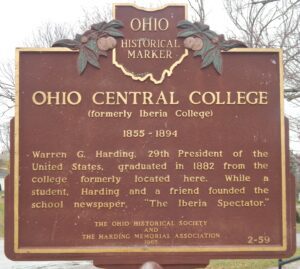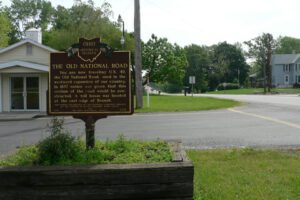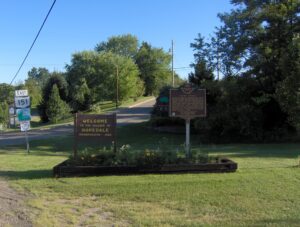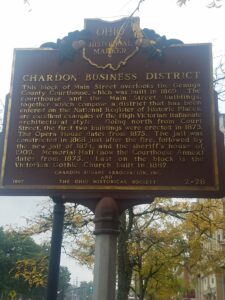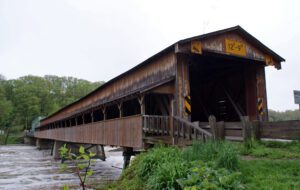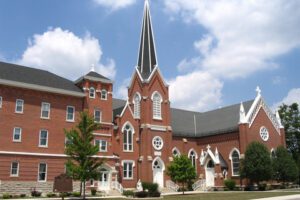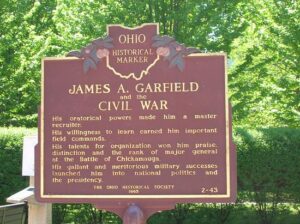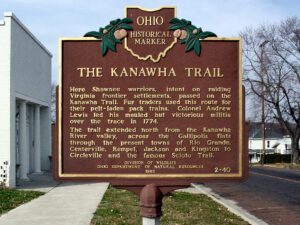, OH
Ohio Central College (formerly Iberia College). Warren G. Harding, 29th president of the United States, graduated in 1882 from the college formerly located here. While a student, Harding and a friend founded the school newspaper, “The Iberia Spectator.”
, OH
You are now traveling U.S. 40, the “Old National Road” used in the westward expansion of our country. In 1837 notice was given that this section of the road would be constructed. A toll house was located at the east edge of Brandt.
, OH
Platted by educator and abolitionist Cyrus McNeely in 1849, Hopedale was the site of McNeely Normal School, later Hopedale Normal College, the first coeducational college for teachers in eastern Ohio. It operated from 1849 to 1902. Among its graduates was George Armstrong Custer in 1856. Hopedale served as an important stop on the Underground Railroad for slaves fleeing bondage in the southern states. Local tradition notes several “stations” in the village, three at private homes and one at a hotel.
, OH
This block of Main Street overlooks the Geauga County Courthouse, which was built in 1869. The courthouse and the Main Street buildings, together which compose a district that has been entered on the National Register of Historic Places, are excellent examples of the High Victorian Italianate architectural style. Going north from Court Street, the first two buildings were erected in 1873. The Opera House dates from 1875. The jail was constructed in 1868 just after the fire, followed by the new jail of 1874, and the sheriff’s house of 1909. Memorial Hall (now the Courthouse Annex) dates from 1875. Last on the block is the Victorian Gothic Church built in 1882.
, OH
Replacing an earlier bridge that was carried away in a spring flood, the Harpersfield Covered Bridge was built in 1868 and spans the Grand River, a state-designated wild, and scenic river. This bridge, which currently carries County Road #154 (Harpersfield Road), is a two-span wooden Howe truss bridge, with center pier. The great flood of 1913 washed away the northern approach and it was at this time that the additional 140 foot steel truss was added. Extensive rehabilitation in 1992 included strengthening the lower chords, lowering and replacing the floor, and adding a cantilevered walkway. The 228-foot-long Harpersfield Bridge is the longest covered bridge in Ohio and is on the National Register of Historic Places.
, OH
The Sisters of the Precious Blood, founded in Switzerland by Maria Anna Brunner in 1834, began their ministry of prayer and education in Mercer County here at Maria Stein (Our Lady of the Rock). Father Francis de Sales Brunner, a Missionary of the Precious Blood, brought the Sisters to America in 1844, and in 1846 established the foundation at Maria Stein, named after a Benedictine Abbey in Switzerland. The convent was the Motherhouse of the Sisters of the Precious Blood until 1923. Relics of the saints were brought to this site from Italy in 1875. The present convent and relic chapel (National Marian Shrine of the Holy Relics), built during 1890-1902, were placed on the National Register of Historic Places in 1976.
, OH
His oratorical powers made him a master recruiter. His willingness to learn earned him important field commands. His talents for organization won him praise, distinction and the rank of major general at the Battle of Chickamauga. His gallant and meritorious military successes launched him into national politics and the presidency.
, OH
Plunging herds of buffalo seeking salt licks and grazing lands wore trails through the Ohio Country when it was an Indian no-man’s land. Later, Indians found the same trails suitable for their needs. The tawny paths were highways as well as highest ways. Indians found ridges and summits superior to valleys for trails because they were drier, windswept of snow, never clogged by flood debris and safer.


